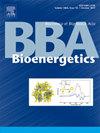The role of retinal chromophore photoisomerization in enhanced inward proton-pumping activity of xenorhodopsin from Nanosalina
IF 2.7
2区 生物学
Q2 BIOCHEMISTRY & MOLECULAR BIOLOGY
引用次数: 0
Abstract
Xenorhodopsin (XeR) is the first identified light-driven inward proton pump, exhibiting proton translocation vectoriality opposite to that of bacteriorhodopsin (BR)—a well-characterized outward proton pump rhodopsin. The molecular mechanism governing this vectoriality remains a fundamental question. A distinguishing feature of XeRs is the substitution of the second counterion (Asp212 in BR) with a proline residue located near the protonated retinal Schiff base (PRSB). The absence of a negatively charged residue in XeRs may hinder proton transfer from the Schiff base to the primary counterion (Asp85 in BR), a key determinant of vectoriality. Several studies have reported that XeR from Nanosalina (NsXeR) exhibits higher inward proton-pumping activity than other XeRs, although the underlying molecular mechanism remains unclear. In this study, we analyzed the early photointermediate (K) of NsXeR using light-induced difference Fourier transform infrared spectroscopy, revealing two characteristic features. First, the distinct hydrogen out-of-plane (HOOP) vibrations—indicative of retinal distortion—were absent, suggesting a minimally distorted retinal chromophore post-photoisomerization in NsXeR. Second, the PRSB exhibited a weaker hydrogen bond in the dark state. Interestingly, substituting Pro209 at the second counterion position with alanine or glycine (P209A and P209G) restored HOOP band intensity and strengthened the PRSB hydrogen bond. Importantly, the P209A and P209G mutants demonstrated reduced inward proton-pumping activity and slower recovery in the final thermal isomerization process compared to the wild type. These findings suggest that photoisomerization without retinal distortion enhances inward proton transport in NsXeR.

视网膜发色团光异构在纳米盐碱中增强异视紫红质向内质子泵送活性中的作用
异视紫红质(XeR)是第一个被发现的光驱动向内质子泵,其质子转运矢量性与细菌视紫红质(BR)相反,后者是一种特性良好的向外质子泵视紫红质。控制这种矢量的分子机制仍然是一个基本问题。xer的一个显著特征是用位于质子化视网膜希夫碱(PRSB)附近的脯氨酸残基取代BR中的第二个对离子(Asp212)。xer中缺乏带负电荷的残基可能会阻碍质子从希夫碱转移到主要对偶离子(BR中的Asp85),这是矢量性的关键决定因素。一些研究报道了来自纳米盐的XeR (NsXeR)比其他XeR表现出更高的向内质子泵活性,尽管潜在的分子机制尚不清楚。本研究利用光致差分傅里叶变换红外光谱分析了NsXeR的早期光中间体(K),揭示了两个特征。首先,明显的氢面外(HOOP)振动(表明视网膜扭曲)不存在,表明NsXeR光异构后视网膜发色团有轻微扭曲。其次,PRSB在暗态表现出较弱的氢键。有趣的是,用丙氨酸或甘氨酸(P209A和P209G)取代Pro209在第二个对偶位置恢复了HOOP带强度并增强了PRSB氢键。重要的是,与野生型相比,P209A和P209G突变体表现出向内质子泵送活性降低,在最终热异构化过程中恢复较慢。这些发现表明,无视网膜畸变的光异构化增强了NsXeR中向内的质子传递。
本文章由计算机程序翻译,如有差异,请以英文原文为准。
求助全文
约1分钟内获得全文
求助全文
来源期刊

Biochimica et Biophysica Acta-Bioenergetics
生物-生化与分子生物学
CiteScore
9.50
自引率
7.00%
发文量
363
审稿时长
92 days
期刊介绍:
BBA Bioenergetics covers the area of biological membranes involved in energy transfer and conversion. In particular, it focuses on the structures obtained by X-ray crystallography and other approaches, and molecular mechanisms of the components of photosynthesis, mitochondrial and bacterial respiration, oxidative phosphorylation, motility and transport. It spans applications of structural biology, molecular modeling, spectroscopy and biophysics in these systems, through bioenergetic aspects of mitochondrial biology including biomedicine aspects of energy metabolism in mitochondrial disorders, neurodegenerative diseases like Parkinson''s and Alzheimer''s, aging, diabetes and even cancer.
 求助内容:
求助内容: 应助结果提醒方式:
应助结果提醒方式:


